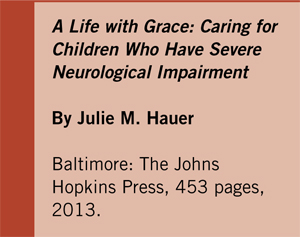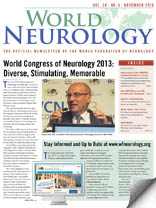
BOOK REVIEW
By Lawrence W. Brown, MD
In a totally unscientific anecdotal analysis, I have found that child neurologists are the most caring and empathetic physicians of all specialists. Unfortunately, most of us have neither the time, the training nor the resources to provide comprehensive care for all of our patients with severe neurological impairment.
A Life with Grace; Caring for Children Who Have Severe Neurological Impairment goes a long way in showing that it is possible to act collaboratively with parents and other members of the care team in order to provide a humane and realistic approach to intellectual disabilities and other static and progressive encephalopathies. This book may be directed at parents and caregivers, but it strikes a responsive chord in many health care providers like myself who accept and encourage a family-centered approach that redefines palliative care far beyond end-of-life support. Rather, it can aim to ensure the best possible quality of life for the child while accepting that medicine does not have all the answers. And even when we think we know the right approach, it is essential to accept families as partners in the decision-making process.
The most successful chapters are symptom-oriented discussions such as pain, seizures, GI complaints and respiratory problems. It doesn’t matter if the underlying diagnosis is Trisomy 21 or Rett syndrome since identification of a disruptive symptom such as pain and its differential diagnosis is similar in all neurologically impaired children who cannot communicate or even localize the problem. The author is frank about her opinion that favors an empirical approach, which minimizes testing and offers treatment based on likelihood of diagnosis and availability of effective non-invasive interventions. At the same time, Hauer suggests that there is a role for intensive investigations if the symptoms persist despite the first steps.
In a book written to a lay audience, there is a plethora of information including worrisome side effects and drug interactions, but little advice on how to prioritize among choices — while confusing, this is reasonable if one understands that expert diagnosticians must look at the individual child and negotiate the options with skill and finesse. She also offers some practical algorithms for specific symptoms (with validated scales where available), a time frame for the recommended clinical trial, the importance of regular assessment of outcome and a sensible guide to discontinuing medication when the treatment has failed to achieve its goals. Perhaps equally important is the emphasis (both to parents and neurologists) on non-pharmacological approaches from simple comfort measures such as massage, repositioning and reduced total volume with slower tube feeding to alternative strategies such as acupuncture.
Child neurologists may particularly appreciate the discussion that recognizes that almost any CNS symptom (from spasticity to dystonia to seizures) can worsen as a result of any factor altering comfort — pain illness, constipation, disrupted sleep, medication toxicity, etc. It is equally important to recognize that many behaviors that could be seizures in children with severe neurological impairment (even in those with definite epilepsy) have non-epileptic explanations for their arching, posturing, exaggerated startle reactions and staring.
The chapter on seizures is valuable for child neurologists with recommendations for tube-fed children, guidelines for rectal administration of drugs and the restrained use of blood levels. One disappointment is the brevity of the discussion on medically refractory epilepsy in this population. I would have preferred to see more emphasis on surgery since this is still the only real option for cure. Even though limited resection is less likely to be successful in severely involved children, there are many examples of excellent outcomes in selected cases of tuberous sclerosis and cortical dysplasia in patients with intellectual disability and autism. Beyond focal resection, it is equally important in a book emphasizing quality of life to more fully discuss the value of the ketogenic diet, vagus nerve stimulator and corpus callosotomy — all of which can be life-changing in the well-chosen patient.
The least successful chapters come early in the book – what I call Neurology 101. Indeed, it is necessary to review static versus progressive disorders, but to highlight a handful of examples trivializes the complexity of the diagnostic challenges and is confusing in the overlap of distinguishing symptoms. In the era of molecular genetics and pharmacogenomics, it is insufficient to list 12 random genetic disorders or to spend two pages explaining brain pathology in children with all of the conditions that can lead to severe neurological impairment.
There are many valuable points that can help the treating neurologist in areas that are at the edge of his or her knowledge. These include GI issues from the risk of diarrhea from excessive sorbitol in liquid medications to constipation not only as a source of pain, but also as a cause of urinary retention and bladder infections. In addition, there are consequences of delayed GI motility including distension, abdominal pain and chronic diarrhea. There are equally valuable pointers in the respiratory chapter such as techniques to manage dyspnea from stimulation by a fan to repositioning and use of benzodiazepines to reduce anxiety as well as the recognition that treatment of excessive secretions with anticholinergics must balance the goal of reduced secretion with the risk of thicker secretions that are more difficult to mobilize and can worsen constipation.
Particularly helpful for physicians as well as parents are the case examples spread throughout the book. These address the decision points that go into a fully informed plan to address critical issues like whether to perform tracheotomy or spinal surgery, how to manage recurrent respiratory crises and even withdrawal of support respecting life without extending death.
In summary, this is a unique and valuable resource for parents and neurologists alike. It beautifully manages the almost impossible by speaking at a high level without excessive scientific jargon and incorporating a glossary of medical terms for the laymen while including timely and extensive peer-reviewed references at the end of each chapter for physicians.
Brown is at the Children’s Hospital of Philadelphia, Philadelphia, PA.
